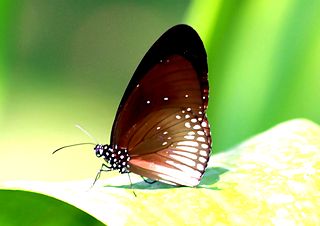
Brachychiton acerifolius is a large tree of the family Malvaceae endemic to tropical and subtropical regions on the east coast of Australia. It is famous for the bright red bell-shaped flowers that often cover the whole tree when it is leafless. It is commonly known as the flame tree, Illawarra flame tree, lacebark tree, or kurrajong.

Atalaya is a genus of eighteen species of trees and shrubs of the plant family Sapindaceae. As of 2013 fourteen species grow naturally in Australia and in neighbouring New Guinea only one endemic species is known to science. Three species are known growing naturally in southern Africa, including two species endemic to South Africa and one species in South Africa, Eswatini and Mozambique.

Normanbya is a monotypic genus of palms containing the single species Normanbya normanbyi, which is known by the common name black palm It is endemic to Queensland, Australia and is threatened by habitat destruction.

Pseuduvaria is a genus of the plant family Annonaceae and tribe Miliuseae: with a native range is Tropical Asia.
Tylophora is a former genus of climbing plants or vines, first described as a genus in 1810. The genus was originally erected by Robert Brown for four species he described in Australia. It was synonymized with Vincetoxicum in 2018, a decision accepted by Plants of the World Online as of February 2023.

Wendlandia is a genus of flowering plants in the family Rubiaceae. It is found in northeastern tropical Africa, and from tropical and subtropical Asia to Queensland.
Beilschmiedia bancroftii is a tree species in the family Lauraceae. It is native to Queensland in Australia. Common names include yellow walnut, yellow nut and canary ash.

Xanthostemon chrysanthus, commonly known as golden penda, is a species of tree in the myrtle family Myrtaceae which is endemic to north eastern Queensland, Australia. It is a popular garden plant with showy yellow blooms, and is the floral emblem of the city of Cairns.

Hedraianthera is a genus of a sole recognised species of shrubs or small trees endemic to Australia from the family Celastraceae.

Vincetoxicum barbatum, synonym Tylophora barbata, the bearded tylophora, is a small vine in the dogbane family. A common plant found south of Bulahdelah, New South Wales. The habitat is rainforest and moist eucalyptus forests in south eastern Australia. Not often seen in flower, but flowers are dark red, around 7 mm long on thin stalks. Broken branches produce watery or milky sap.

Euploea alcathoe, commonly known as the no-brand crow, Eichhorn's crow or striped black crow, is a common butterfly found from India to Borneo, and in the Moluccas, New Guinea and Australia. It belongs to the crows and tigers subfamily of the Nymphalidae.
Hollandaea is a small genus of plants in the family Proteaceae containing four species of Australian rainforest trees. All four species are endemic to restricted areas of the Wet Tropics of northeast Queensland.
Brassiantha hedraiantheroides is a species of Australian understory shrubs or small trees, constituting part of the plant family Celastraceae. In 2012 botanist Andrew J. Ford formally scientifically named and described them as the first recognised Australian species of the genus Brassiantha. Previously several publications provided informal scientific descriptions of this species under the provisional names "Hedraianthera sp. Mossman Qld Herbarium" or "Hedraianthera sp. Mossman".

Synima is a genus of tropical rainforest trees, constituting part of the plant family Sapindaceae.
Canarium muelleri, commonly named scrub turpentine or mangobark, is a species of Australian rainforest trees in the plant family Burseraceae. They are endemic to northeastern Queensland, widespread in the rainforests of the Wet Tropics region, and further south to the Conway Range area, near Proserpine, Queensland.

Peripentadenia is a genus of two species of large trees from the family Elaeocarpaceae endemic to the rainforests of northeastern Queensland, Australia. Sometimes they have the common name quandong.
T. floribunda may refer to:

Syzygium angophoroides, commonly known as bark in wood, Yarrabah satinash, or swamp satinash, is a tree of the family Myrtaceae native to Western Australia, the Northern Territory and Queensland in Australia, which grows to a height of 6 to 35 m. It blooms between July and November producing cream flowers, followed by small fruits about 9 mm long by 13 mm wide, which turn dark purple or blackish when ripe.

Archidendron vaillantii, commonly known as the salmon bean, is an evergreen tree in the legume family Fabaceae. It is endemic to the rainforests of northeast Queensland.

Cleistanthus apodus, commonly known as the weeping Cleistanthus, is a tree in the family Phyllanthaceae native to New Guinea and northeast Queensland. It was first described in 1873 by the English botanist George Bentham in his seven-volume book Flora Australiensis.














